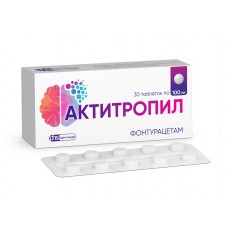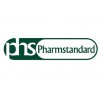Expiration date: 07/2026
Form of release
Tablets, 100 mg - 30 pieces per pack.
Dosage form
Flat-cylindrical tablets from white to white with a yellowish or brownish tinge of color with a risk on one side and a chamfer, marbling is allowed.
Composition
Per 1 tablet
Active substance:
Fonturacetam 118.0 mg (in terms of 100% substance) 100.0 mg
Auxiliary substances
Microcrystalline cellulose 101 18.0 mg
Povidone K-17 (low molecular weight polyvinylpyrrolidone K-17) 40.0 mg
Hyprolose (hydroxypropyl cellulose) 20.0 mg
Sodium bicarbonate 20.0 mg
Stearic acid 2.0 mg
Pharmacotherapeutic group
nootropic agent
Pharmacodynamics
A nootropic drug, it has a pronounced antiamnestic effect, has a direct activating effect on the integrative activity of the brain, promotes memory consolidation, improves concentration and mental activity, facilitates the learning process, increases the speed of information transfer between the cerebral hemispheres, increases the resistance of brain tissues to hypoxia and toxic effects, It has an anticonvulsant effect and anxiolytic activity, regulates the processes of activation and inhibition of the central nervous system, improves mood.
It has a positive effect on metabolic processes and blood circulation in the brain, stimulates redox processes, increases the energy potential of the body due to glucose utilization, and improves regional blood flow in ischemic areas of the brain. It increases the content of norepinephrine, dopamine and serotonin in the brain, does not affect the level of GABA, does not bind to either GABA or GABA receptors, and does not significantly affect the spontaneous bioelectric activity of the brain.
It has no effect on respiration and the cardiovascular system, exhibits an undetectable diuretic effect, and has anorexic activity when administered in a course of administration.
The stimulating effect is manifested in its ability to have a moderately pronounced effect on motor reactions, in increasing physical performance, in pronounced antagonism to the cataleptic action of antipsychotics, as well as in reducing the severity of the hypnotic effects of ethanol and hexenal.
The psychostimulating effect prevails in the ideatory sphere.
The moderate psychostimulating effect of the drug is combined with anxiolytic activity, improves mood, has some analgesic effect, increasing the threshold of pain sensitivity.
The adaptogenic effect is manifested in increasing the body's resistance to stress in conditions of excessive mental and physical exertion, fatigue, hypokinesia and immobilization, at low temperatures.
Against the background of the reception, an improvement in vision was noted, which is manifested in an increase in acuity, brightness and visual fields.
Improves blood supply to the lower extremities.
It stimulates the production of antibodies in response to the introduction of an antigen, which indicates its immunostimulating properties, but at the same time it does not contribute to the development of hypersensitivity of the immediate type and does not change the allergic inflammatory reaction of the skin caused by the introduction of a foreign protein.
With course use, drug dependence, tolerance, and "withdrawal syndrome" do not develop.
The effect begins with a single dose, which is important when using the drug in extreme conditions.
It has no teratogenic, mutagenic, carcinogenic or embryotoxic properties. The toxicity is low, and the lethal dose in an acute experiment is 800 mg/kg.
Pharmacokinetics
Suction
It is rapidly absorbed, penetrates into various organs and tissues, and easily passes through the blood-brain barrier.
Distribution
The absolute oral bioavailability is 100%. The maximum concentration in the blood (Tmax) is reached after 1 hour, the half-life (T1/2) is 3-5 hours.
Metabolism
It is not metabolized in the body.
Withdrawal
It is excreted unchanged: approximately 40% in urine and 60% in bile and sweat.
Indications
- Diseases of the central nervous system of various origins, especially associated with vascular diseases and metabolic disorders in the brain, intoxication (in particular, in post-traumatic conditions and chronic cerebrovascular insufficiency), accompanied by deterioration of intellectual and mnestic functions, decreased motor activity;
- Neurotic conditions, manifested by lethargy, increased exhaustion, decreased psychomotor activity, impaired attention, memory impairment;
- Violations of the learning process;
- Obesity (alimentary-constitutional origin);
- Prevention of hypoxia, increasing resistance to stress, correction of the functional state of the body in extreme conditions of professional activity in order to prevent the development of fatigue and to improve mental and physical performance;
- Chronic alcoholism (in order to reduce the phenomena of asthenia, intellectual and mnestic disorders).
Contraindications
- Hypersensitivity to the active substance and / or to any excipient of the drug;
- Pregnancy;
- The breastfeeding period;
- Children under 18 years of age (safety and efficacy of the drug have not been established)
With caution
Patients with severe organic liver and kidney damage, severe hypertension, severe atherosclerosis, who have previously suffered panic attacks, acute psychotic states with psychomotor agitation due to the possibility of exacerbation of anxiety, panic, hallucinations and delusions, as well as patients prone to allergic reactions to nootropic drugs of the pyrrolidone group.
Use during pregnancy and lactation
It should not be prescribed during pregnancy and lactation due to the lack of clinical research data.
Method of administration and dosage
Inside.
Take immediately after meals. The dose and duration of treatment should be determined by the doctor. The doses vary depending on the patient's condition. The average single dose is 150 mg (from 100 to 250 mg); the average daily dose is 250 mg (from 200 to 300 mg). The maximum allowable dose is 750 mg/day. It is recommended to take a daily dose of up to 100 mg once in the morning, and over 100 mg divided into 2 doses. The duration of treatment can vary from 2 weeks to 3 months, with an average of 30 days. If necessary, the course can be repeated after 1 month.
To improve performance - 100-200 mg once in the morning, for 2 weeks (for athletes - 3 days).
The recommended duration of treatment for patients with alimentary constitutional obesity is 30-60 days at a dose of 100-200 mg once a day (in the morning). It is not recommended to take the drug later than 15 hours.
Side effects
Insomnia (if the drug is taken later than 15 hours). In some patients, psychomotor agitation, hyperemia of the skin, a feeling of warmth, and an increase in blood pressure are possible during the first 1-3 days of admission.
Overdose
There were no cases of overdose.
Treatment: symptomatic therapy.
Drug interaction
Fonturacetam can enhance the effect of drugs that stimulate the central nervous system, antidepressants and nootropic drugs.
The drug exhibits pronounced antagonism to the cataleptic action of antipsychotics, and also weakens the severity of the hypnotic effects of ethanol and hexobarbital.
Special instructions
With excessive psychoemotional exhaustion against the background of chronic stress and fatigue, chronic insomnia, a single dose of the drug on the first day may cause a sharp need for sleep. Such patients on an outpatient basis should be advised to start taking the drug on non-working days.
Influence on the ability to drive vehicles, mechanisms
Care should be taken when driving vehicles and mechanisms, especially during the first days of admission, given the possible occurrence of drowsiness (see section "Special instructions").
Storage temperature
from 2℃ to 25℃


